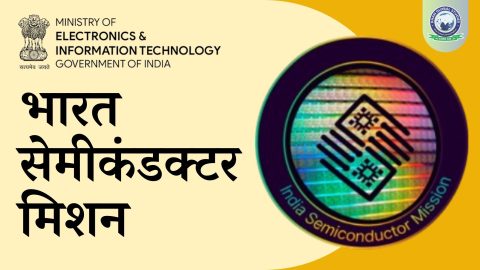India Semiconductor Mission (ISM) is a landmark initiative aimed at transforming India’s semiconductor industry. In an era where semiconductors are the backbone of modern technology, this mission seeks to make India a global hub for semiconductor manufacturing and innovation. Let’s find out what this mission entails and why it is a game-changer for India.
Objectives of India Semiconductor Mission
- Promoting domestic manufacturing: One of the key objectives of ISM is to enhance domestic semiconductor manufacturing capabilities. This includes setting up state-of-the-art fabrication plants (fabs) and creating infrastructure to produce high-quality semiconductors within the country.
- Reducing dependence on imports: Currently, India relies heavily on semiconductor imports to meet its technological needs. The mission aims to reduce this dependence by promoting a self-reliant semiconductor ecosystem, which will help protect national security and reduce the trade deficit.
- Enhancing Technological Competitiveness: By focusing on advanced research and development, ISM aims to keep India at the forefront of technological innovation. This includes developing cutting-edge semiconductor technology and applications that can compete globally.
Vision of India Semiconductor Mission
- Long-term Goal: The long-term vision of ISM is to establish India as a leading player in the global semiconductor market. This includes not only manufacturing semiconductors but also becoming a hub for semiconductor design, research, and innovation.
- Strategic Importance: Semiconductors are critical to various strategic sectors including defense, communications, and computing. By strengthening its semiconductor industry, India aims to secure its technological sovereignty and strategic autonomy.
- Economic and Technological Impact: The mission is expected to have a profound impact on the Indian economy through the creation of jobs, attracting investments, and fostering a high-tech ecosystem. Additionally, it will accelerate the adoption of digital technologies across various sectors.
Key Features of India Semiconductor Mission
- Government Incentives and Support: The Government of India is offering several incentives to attract investments in the semiconductor sector. This includes financial subsidies, tax exemptions and policy support to create a conducive environment for semiconductor manufacturing and innovation.
- Infrastructure Development: Developing a strong infrastructure is critical to the success of ISM. This includes setting up semiconductor manufacturing units, testing and packaging facilities, and establishing reliable supply chains for raw materials and components.
- Collaboration with Global Players: ISM encourages collaboration with leading global semiconductor companies and research institutes. Such partnerships will help in technology transfer, skill development and joint ventures that can accelerate the growth of India’s semiconductor industry.
- Focus on Research and Development: At the heart of ISM is research and development. The mission aims to establish centres of excellence and innovation centres that focus on developing next-generation semiconductor technologies and applications.
Challenges and Solutions
- Current Challenges in the Semiconductor Industry: The semiconductor industry is facing several challenges, including high capital costs, technical complexities, and supply chain disruptions. Addressing these challenges requires a coordinated effort from the government, industry, and academia.
- Solutions Proposed by the Mission: ISM proposes solutions such as financial incentives, investments in infrastructure, and skill development programs. Additionally, fostering a collaborative environment for innovation and research will help overcome these challenges.
Impact on Various Sectors
- Electronics and IT: The electronics and IT sectors are expected to benefit significantly from ISM. Enhanced semiconductor manufacturing capabilities will boost the production of advanced electronic devices and IT infrastructure, thereby driving digital transformation.
- Automotive Industry: The automotive industry, which is increasingly dependent on semiconductor technologies for electric vehicles and autonomous driving, will witness substantial growth and innovation due to the mission’s focus on semiconductor manufacturing.
- Telecommunications: With the advent of 5G and beyond, the telecommunications sector requires cutting-edge semiconductors for network infrastructure and devices. ISM will ensure a steady supply of high-performance semiconductors for this sector.
- Healthcare: Semiconductors are critical for medical devices and healthcare technologies. ISM will support the development and production of advanced healthcare solutions, thereby improving the quality of medical care.
Role of Education and Skill Development
- Training and Skill Development of Workforce: To support the growth of the semiconductor industry, a skilled workforce is required. ISM emphasizes on training and skill development programs to prepare engineers, technicians, and researchers for the semiconductor sector.
- Collaboration with academic institutions: Partnerships with academic institutions are essential to build a talent pipeline. ISM encourages collaboration between universities, research institutions, and industry to promote innovation and skill development.
Environmental Considerations
- Sustainable manufacturing practices: ISM promotes sustainable manufacturing practices to reduce the environmental impact of semiconductor production. This includes adopting energy-efficient processes and reducing waste and emissions.
- Energy efficiency in semiconductor production: Improving energy efficiency in semiconductor manufacturing is critical to sustainability. The mission focuses on developing technologies and practices that reduce energy consumption and increase overall efficiency.
Global Comparison
- How does India’s mission compare to other countries?: Comparing India’s semiconductor mission to other countries provides valuable information. Understanding global best practices and benchmarks will help improve ISM for better results.
- Lessons from global leaders: By learning from the experiences of global leaders in the semiconductor industry, India can gain guidance in overcoming challenges and achieving its goals. Collaborative efforts and knowledge sharing are key components of this strategy.
Potential Risks and Mitigation
- Economic Risks: Economic risks include fluctuations in market demand, investment uncertainties, and global economic conditions. Mitigation strategies include creating a stable investment climate and diversifying the semiconductor market.
- Technological Risks: Technological risks arise from rapid advancements and the need for constant innovation. Investing in research and development and promoting a culture of innovation will help mitigate these risks.
- Policy Risks: Policy risks include changes in government policies and regulatory frameworks. Ensuring consistent and supportive policies will attract investments and promote the growth of the semiconductor industry.
Conclusion
The India Semiconductor Mission is a visionary initiative that aims to transform India into a global semiconductor hub. By focusing on domestic manufacturing, reducing import dependence, and enhancing technological competitiveness, the mission sets the stage for significant economic and technological progress. Although challenges exist, a strategic approach and broad support from government and industry stakeholders promise a bright future for India’s semiconductor sector.
Frequently Asked Questions
Question: What is the India Semiconductor Mission?
Answer: The India Semiconductor Mission is a government initiative that aims to develop a strong semiconductor ecosystem in India, focusing on manufacturing, research, and innovation.
Question: Why is the semiconductor industry important?
Answer: Semiconductors are essential components in various electronic devices and systems, driving advancement in technology, communications, healthcare, and more.
Question: What are the main objectives of the India Semiconductor Mission?
Answer: The main objectives include boosting domestic manufacturing, reducing import dependency, and enhancing technological competitiveness in the global semiconductor market.
Question: How will the mission impact India’s economy?
Answer: The mission will create jobs, attract investments, promote innovation, and contribute to economic growth by establishing India as a major player in the global semiconductor industry.
Question: What are the challenges faced by the mission?
Answer: The challenges include high capital costs, technical complexities, supply chain disruptions, and the need for a skilled workforce. The mission addresses these through financial incentives, infrastructure development, and skill training programs.



